In place of the celebration, the archbishop presided over a mass for 17 people killed in a two day conflict over access to tin mines. As an uneasy peace returned to the town, a nearby soccer field-turned-battlefield was still carved up by craters from dynamite explosions and stained red with the blood of miners.(1)
Only six days after two coca farmers were killed by soldiers sent to eradicate unauthorized coca crops in a remote national park in
The desperation that led the miners of Huanuni to turn their sticks of dynamite into weapons is the product of neoliberal policies that pit the poor against the poor. International corporations have siphoned the profits of Huanuni’s Posokoni hill, the richest tin mine in
Mining is a terrible job anywhere in the world. It’s particularly unhealthy and dangerous in
A History Underground
"If in the past it was the dictatorships that sowed mourning in the mining camps, today unemployment, marginalization and hereditary poverty of neoliberalism were the breeding ground for the confrontation between brothers for the possession of the rich deposits of the Posokoni hill." – Journalist with the Agencia Boliviana de Información (2)
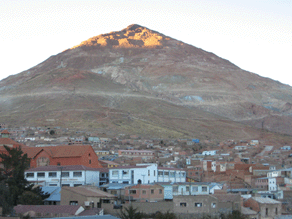
After Spanish colonists emptied Bolivian hills like Potosí of most of their silver in the 1600’s, tin became king of Bolivian mines. According to historical accounts, Huanuni was called Kcoya Orco, or "Hill of the Mines" and was discovered in the 19th century. Local legend has it that its present name came from the intense cold in the area, capable of making stones break, leading to the Aymara name "wañuchi," which means "I have suffered," or "I’ve learned my lesson." (3)
During the 20th century, Huanuni was owned by
The unionized mine workers have played a notable role in the Bolivian workers movement. From the reign of Patiño and into the Revolution of 1952, the union has fought for workers’ rights, gaining an 8 hour work day in 1919, and the nationalization of the mines in 1952. The conflict which recently tore Huanuni apart has its roots in
The Revolution of 1952
The ascent to power of the Movement Toward Socialism, (MAS, the party of Evo Morales), which refers to itself as a "political instrument" for its social movement base, harkens back to the style in which revolutionary fervor among, workers, farmers and students was channeled through the Revolutionary National Movement (MNR) party, paving the way to the 1952 Revolution. Leading up to this revolution, the population united in its demands for better wages and working conditions, redistribution of land, nationalization of the mines and access to education and healthcare. The MNR party ran Victor Paz Estenssoro as their candidate for change in 1951. He won a clear victory, but the army intervened, placing General Hugo Ballivian in Estenssoro’s rightful place. The MNR knew taking power by force would be their only option.(6)
On the night of April 10, 1952, the army, with Ballivian at the helm, ordered all lights to be put out in
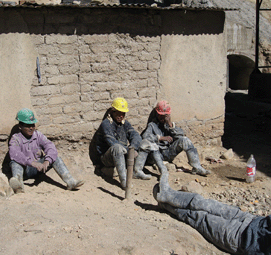 Estenssoro arrived in the El Alto airport from exile in Buenos Aires, Argentina on April 15th to a crowd of 7,000 people who waved placards saying "Nationalization of the mines," "Agrarian Reform," and "Welcome, father of the poor." The crowd was so large that it took Estenssoro thirty minutes to walk half a block to the presidential palace. He started his speech to the crowd in Aymara, the language most of the audience spoke: "Jacca t’anta uthjani" (There will be a lot of bread).(10) Three days after Estenssoro assumed power, the recently founded Bolivian Worker’s Center (COB), demanded that the MNR nationalize of the country’s mines without payment to owners, redistribute land to poor farmers, grant citizens universal suffrage, and formalize the armed worker and campesino militias to replace the military. Such demands coming from the COB and other worker and farmer movements pushed the MNR to make more radical changes quickly.(11)
Estenssoro arrived in the El Alto airport from exile in Buenos Aires, Argentina on April 15th to a crowd of 7,000 people who waved placards saying "Nationalization of the mines," "Agrarian Reform," and "Welcome, father of the poor." The crowd was so large that it took Estenssoro thirty minutes to walk half a block to the presidential palace. He started his speech to the crowd in Aymara, the language most of the audience spoke: "Jacca t’anta uthjani" (There will be a lot of bread).(10) Three days after Estenssoro assumed power, the recently founded Bolivian Worker’s Center (COB), demanded that the MNR nationalize of the country’s mines without payment to owners, redistribute land to poor farmers, grant citizens universal suffrage, and formalize the armed worker and campesino militias to replace the military. Such demands coming from the COB and other worker and farmer movements pushed the MNR to make more radical changes quickly.(11)
On July 21, 1952, the government established the right to vote for everyone over the age of 21, bringing 80% of the population into the electorate. In spite of this hopeful, democracy was not truly established. Yet rights were gained none the less, in the way that Bolivians have often found most successful, through the pressuring of institutions from below. Campesinos and unions of rural workers, using their arms from the Revolution, applied their own systems of justice through militias, took over land, reorganized systems of production and often superceded the power of local political authorities.(12) This took place at the grassroots; the MNR was unwilling to enact such changes.
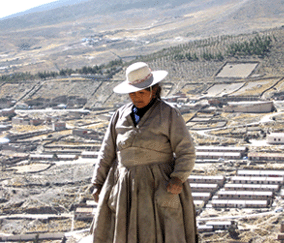 Due to pressure from their base of labor organizations and miners, the MNR signed a decree which nationalized the country’s mines on October 31, 1952. An enormous crowd of miners gathered at the event to celebrate the signing with cheers, dynamite explosions and gun shots into the air. The festivities raged for days. The worker-run Bolivian Mining Corporation (COMIBOL).(13) took over the operation of 163 mines and 29,000 workers formerly controlled by Patino, Hochschild and Aramayo, the three mining baron families. In spite of the demands from the COB to not pay the owners a cent, the families were given $27 million for their wealth underground.(14)
Due to pressure from their base of labor organizations and miners, the MNR signed a decree which nationalized the country’s mines on October 31, 1952. An enormous crowd of miners gathered at the event to celebrate the signing with cheers, dynamite explosions and gun shots into the air. The festivities raged for days. The worker-run Bolivian Mining Corporation (COMIBOL).(13) took over the operation of 163 mines and 29,000 workers formerly controlled by Patino, Hochschild and Aramayo, the three mining baron families. In spite of the demands from the COB to not pay the owners a cent, the families were given $27 million for their wealth underground.(14)
Meanwhile, pressure continued from below to radicalize the MNR government. Poor, armed campesinos in various parts of the country occupied land and pressured the government to break up large farms, expropriate and redistribute land.(15) As a result, the MNR passed the Agrarian Reform Law in August of 1953 which met these demands. However, on a national level the land reform only affected 28.5% of the large landowners. The MNR had been pressured by grassroots forces to make these drastic changes. As time went on, right wing elements within the MNR pushed these radical labor and agrarian groups – particularly the COB – out of the political sphere, co-opted and weakened social movements.(16) On May 14, 1953, Estenssoro applied policies pushed by the World Bank and International Monetary Fund (IMF), leading to inflation which tripled the cost of living in
Neoliberalism in
In 1985, as poverty soared, wages dropped and the government was unable to pay its debt to the International Monetary Fund (IMF), Jeffrey Sachs, a Harvard Professor, drew up a plan to save
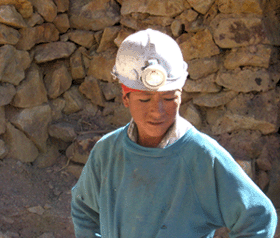
The Bolivian government adopted the decree, a move applauded by the IMF, which subsequently gave
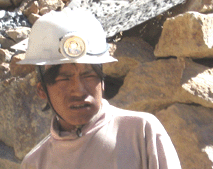 In March 1994, President Sanchez de Lozada passed the Law of Capitalization which was supposed to boost GDP and save the country from its economic depression, but produced the opposite results. The law approved the sale of the country’s telephone company, airlines, trains, mining, oil and gas companies.(22) This term in office is best remembered by Bolivians as a period in which he privatized many state run industries, a policy he promised would spur growth. However, the wealth of these transactions helped out the small elite which Sanchez de Lozada was a part of, and never reached a majority of the poor populace. Instead of strengthening the economy, the country fell into a crisis. In an interview in 2001, Sanchez de Lozada described this first term in office: "Decree 21060 [Law of Capitalization] changed
In March 1994, President Sanchez de Lozada passed the Law of Capitalization which was supposed to boost GDP and save the country from its economic depression, but produced the opposite results. The law approved the sale of the country’s telephone company, airlines, trains, mining, oil and gas companies.(22) This term in office is best remembered by Bolivians as a period in which he privatized many state run industries, a policy he promised would spur growth. However, the wealth of these transactions helped out the small elite which Sanchez de Lozada was a part of, and never reached a majority of the poor populace. Instead of strengthening the economy, the country fell into a crisis. In an interview in 2001, Sanchez de Lozada described this first term in office: "Decree 21060 [Law of Capitalization] changed
Unionists and Cooperativists
Huanuni miners were also affected by the economic crisis of the 1980s brought on by neoliberal policies. Though many miners migrated elsewhere with their families, some remained in the mines, forming independent cooperatives to work on their own. As prices recovered in the 1990s, some returned, forming powerful cooperative entities. The number of cooperative mine workers rose from
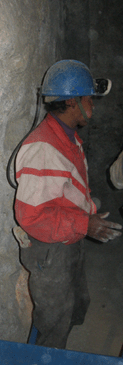 According to a recent study, more than 80% of Bolivian miners are now cooperativists, due mostly to the privatization of the industry. Until 1980, the FENCOMIN contained approximately 17,000 miners. Recent estimates put the levels of cooperative miners in
According to a recent study, more than 80% of Bolivian miners are now cooperativists, due mostly to the privatization of the industry. Until 1980, the FENCOMIN contained approximately 17,000 miners. Recent estimates put the levels of cooperative miners in
The majority of the disputed Posokoni deposit in Huanuni was sold to Allied Deals PLC as the Empresa Minera Huanuni (EMH) in 2000 under the government of Hugo Banzer for $501,123 dollars and the promise to invest $10.25 million dollars in the first two years of business. This kind of almost "no money down" deal was typical of privatization under neoliberal governments.
Part of the mine was also owned by COMIBOL, the nationalized mining company, which Sanchez de Lozada couldn’t completely destroy due to its inclusion in the Constitution. According to the
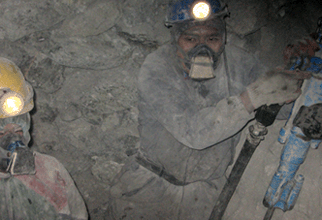 Ten days after the fall of Allied Deals, COMIBOL sought legal intervention on their own behalf, and on November 15 of
Ten days after the fall of Allied Deals, COMIBOL sought legal intervention on their own behalf, and on November 15 of
In the same year of 2003, the price of metals in the international market, including tin, began to rise steeply due to growth in the Asian economy. The once deserted tin mines began to take on a new hue of desirability, which generated confrontations between salaried and cooperative workers who wanted more control of deposits in
During this time, the FELCOMIN cooperative federation began to strengthen their position economically as well as politically, expanding their mining activities in places that didn’t require large investments to explore. For this reason, the possibility of gaining control over the deposits owned by Allied Deals’ Empresa Minera Huanuni in
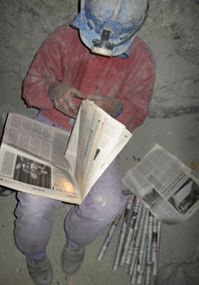
On June 5, 2006, COMIBOL heightened pressure for the transfer of the EMH to their direction, backing up their claims with Law 2400, as no previous government had ever enacted the law. At the beginning of the year, FENCOMIN began their campaign to buy the EMH, and to pressure the government and incite their bases to take over the mines. On January 17, 2006, the Playa Verde Cooperative offered the intervening Grant Thornton and RBG $500,000 to sign a contract with the option of buying their shares. In February, negotiations took place in
Osvaldo Guachalla H, an investigator of the Bolivian Observatory of Extractive Industries (OBIE), expressed his "surprise and indignation that the cooperative mining sector, which has been favored with minimal contributions to the state (they pay only 1% of rent and 1.8% in contribution to the National Health Bank, when everyone else pays 10%, and they have a series of loan forgiveness plans) have the financial power to buy shares in the same high mercantile and capitalist style that they say they condemn."
A Time Bomb
The ore mined in Huanuni from the bowels of Posokoni produces approximately 10,000 fine metric tons of tin annually, a little less than half of Bolivian production and 5% of world production.(34) Current world market prices for tin amount to over seven dollars a pound, or six times the 2004 prices.(35) This rise in prices has also made ownership of the mines more valuable, and the relationship between competing mining factions more tense. Most workers for both sectors are poor, and corruption reigns at top levels. Due to the unstable profit and lack of capital of the cooperativist miners, their sector has received government support in terms of materials, reduced taxes and rent to COMIBOL. This has added to tensions between miners, especially as the possible benefits of the cooperativist gamble have risen with the price of tin.(36)
An inter-institutional technical commission claims that if the tin reserves in Posokoni are "rationally exploited" they could last as long as 30 years. Presently, the salaried miners of the COMIBOL, have set exploitation limits, while the cooperativists – whose daily existence is a gamble on whether they will find a productive tin vein – would like to have free reign. The COMIBOL leaders claim that, were the cooperativists in charge, the mine would be emptied in 2 years, leaving the town in poverty,(37) and subjecting miners to more dangerous conditions.(38)
The mine is divided into levels, and those levels are allotted to the different parties. Mining experts have sustained that in the deepest levels of the mine (-200 and below), which were owned by the Empresa Minera Huanuni of Allied Deals/RBG, exist deposits of tin and silver that could total over $580 million dollars in value.(39) With the materials and infrastructure owned by COMIBOL, the value of the mine cold total $620 million dollars.(40) These are the deposits that both sides would like to claim. Currently Comibol controls the deeper and richest parts of the mines: levels -120 to -320 ("Harrison" levels"), which salaried miners work with state invested in infrastructure, while the cooperativists mine the part closest to the surface, traditionally "Patiño" levels, starting at level 0 at the base of the hill and up, which do not require investments.(41)
In 1995, the FENCOMIN Huanuni signed a rent contract with COMIBOL in order to work some areas below the Patiño level and up, in order to form a fringe security level between the lower
Road to Huanuni
According to the Bolivian newspaper,
Many reports and interviews indicate that the situation in Huanuni was a "time bomb" which the Morales admininstration did not sufficiently pay attention to. The disputes between cooperativistas and salaried workers with COMIBOL had risen to a fevered pitch months ago, leading to numerous protests and road blockades among miners on both sides, demanding the government act. Both sectors have been supporters of the Morales administration.(45) However, through the month of September, both groups blockaded main highways to draw government attention to their demands. In both cases, Morales sent vice president Alvaro García Linera to accept the miners’ petitions in order to end the blockades.(46) However, no solutions were achieved. Alfredo Aguilar, the leader of the Bolivian Miners Federation, said that throughout this time, the government’s position was "first come to an agreement between yourselves, and we’ll settle everything afterwards." Yet Aguilar admitted that they could never come to an agreement because the positions of the two groups were totally at odds with each other.
In the sixteen meetings held with government representatives since March, 2006 every proposal was rejected by one group or the other. "Both sectors (cooperativists and salaried workers) asked the government to leave them exclusively with the Posokoni hill, to exploit [the tin] for their own benefit. They also asked the government to use police and military force to favor their sector to the detriment of the other," said Vice President García Linera.(47) In a June 25 special edition of
The conflict has played into the already divided politics of the miners and the country. Union groups said they had met with the executive branch demanding solutions and dialogue. The COMIBOL and the FSTMB accuse the government of favoring the cooperativists, even though COMIBOL is itself a state owned business. Some accused the Morales administration of ignoring the growing mining dispute due to other issues, primarily the challenges of the gas nationalization and the consituent assembly held in
Accusations have intensified since the appointment of Wálter Villarroel, a registered member of the Salvadora Cooperative, to the position of Minister of Mining.(50) Villarroel, who said that he worked together with both sides,(51) claims that it was "union leaders attached to PODEMOS [the main oppositional party], who are behind this conspiracy."(52) PODEMOS leader, Jorge Quiroga, blames the violence on what he calls the "aggression" of the Morales administration (53) The MAS government first reacted by blaming neoliberalism and poverty, and later blamed the obstinacy of the miners.
The Tin War: Two Days that Shook
The recent conflict in Huanuni started at 2 pm on Wednesday, October 4, when the cooperativists received a letter from the COMIBOL which declared the impossibility of transferring to them the shares of EMH, the mining company formally owned by Allied Deals. Ever Choque, a mining leader, says that the salaried workers received a note from the FENCOMIN 3:00 am Thursday morning stating that the cooperativists would take over the mine. At 3:30 am, Pedro Montes, the secretary of the Bolivian Worker’s Center (COB) got two phone calls alerting him of the cooperativists plans. He then informed the government.(54) At 8 am, the cooperativists assembled midway up the Posokoni hill, near the sector known as Dolores. What happened next is contested by both sides. None the less, it initiated the most violent two days of the Morales administration.
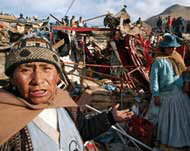
According to Alfredo Aguilar, the president of the salaried workers, it was after the assembly that the cooperativists invaded the mine after destroying the offices of the EMH, as well as the national radio station, the church and houses of the salaried workers. According to radio journalist Wálter Cassia, it was close to 11 am when the cooperativists tried to close the offices of the business with dynamite. Choque sustains that the cooperativists started to advance, throwing sticks of dynamite. "We couldn’t stand there with our arms crossed, we had to react the same way," he said.
According to the cooperativists, however, their intention was to take over the mine "peacefully." Their strategy was to break the compressor that brings air into the mine, and thus force the miners who work the first shift to leave the deposits. The cooperativist director Santos Ramírez Yujra sustained that, at the end of the assembly, the workers decided to go back to work. "In that moment they were surrounded by salaried workers from the business, as well as their wives, commanded by the Army and the Police." Romírez says that the salaried workers advanced, shooting point blank against the cooperativists. According to the government, the soldiers stationed in Huanuni mobilized to avoid greater conflicts between both sectors. The government denies the presence of the military in the beginning of the conflict.
The exchange of dynamite lasted from 11 am to 2 pm, with the skirmishes reaching down to the main plaza of the town. The cooperativists posted themselves in the high part of Posokoni hill, above the Dolores neighborhood, and the salaried workers stayed below. According to one interviewed woman, more cooperativists came from other mines to join the fight with more dynamite while the army used only tear gas. The number of dead and wounded grew by the hour, including miners and residents of all ages.
During the confrontation, the residents of Huanuni gathered in the main plaza, at the church and the offices of EMH, demanding an end to the conflict. Schools and businesses closed, and some accounts told of fights between the wives of miners of both sides, while others said women grouped in the plaza waving white handkerchiefs and yelling "enough, we want peace." Children prayed for an end to the conflict in the church, teachers marched, demanding external intervention, and wives of salaried workers held a government worker hostage, demanding that she convince the government to send in the military to protect the business. Vice president Linera claimed that sending in the soldiers, known for being trigger happy in the face of angry mobs, would be like "throwing gasoline on the fire."
Most residents were simply terrified and stood watching the battle above. They called out to the miners as the two sides – sometimes no more than
The most critical moment came at 2 pm on Thursday, October 5, when a stick of dynamite hit one of the shops where cooperativist miners buy their explosives on the way into the mine. The explosion started a chain reaction, causing 39 other buildings to explode. The salaried miner Salustiano Zurita said the explosion was "like an atomic bomb." 100 families were suddenly made homeless. Many had fled the area when the confrontation started, but two women died inside their houses. Quintín Calle (61), the husband of Teodora Ticona (60), spent the night searching though the rubble of his house with his eight sons. In the morning he walked down the hill to tell the FENCOMIN that he had found his wife. In reality, he had found a scrap of her skirt, pieces of her hair and skin, and a part of her spinal column. The explosion damaged EMH installations, radios, a hospital and clinic, as well as several other institutions. By the end of the day, 9 people were reported dead, and dozens wounded.
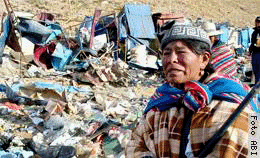
At 8 pm, the Defender of the People (Ombudsperson), the president of the Permanent Assembly of Human Rights, Waldo Albarracín, and the vice minister of the Interior Regime arrived in Huanuni. The delegation managed to call a meeting which lasted into the morning, but established a "pact of peace" signed by both sides. During the discussions, the sound of exploding dynamite echoed from the mountain where miners who were not aware of the meeting continued fighting.(55)
The "Pact of Peace" had four agreements, the first being the commitment to peace in respect for the victims and wounded, the second being a full and forensic investigation of the confrontation to determine those responsible for the violence, the third being to allow the peaceful burial of the dead, and the fourth being that, once peace was established, negotiations with government officials would begin to find a "definitive and effective" solution to the problem.(56)
However, in spite of the pact, the violence continued though the night and into the next morning of Friday, October 6. "Our role has been overruled. We had to leave," said the exasperated Defender of the People, explaining it was up to the government to reach a solution. The government finally announced that 700 policemen would be taken to the town from the city of
The police awaited orders in the patio of the EMH building into the afternoon while the violence continued. At 4 pm one group was sent to take control of Posokoni hill, with the orders of dispersing both sides without the use of force. Another group stayed in town, and a third group took charge of the EMH. Police told journalists that they would only use lethal force in self defense.
The presence of the police was apparently enough to convince the cooperativists to retreat, but it was the archbishop of
Reverse the Curse
While the truce arranged on Friday, October 6 seems as though it might hold, the conflict is far from over. $4 million dollars in damage from the battle has left citizens homeless and business owners destitute.(57) Morales has replaced cooperativist Mining Minister, Wálter Villarroel with ex-salaried worker leader José Guillermo Dalence, and Hugo Miranda Rendón replaced Hugo Molina as the head of the Bolivian Mining Coorporation COMIBOL. Unhappy with Villarroel’s removal in favor of a salaried leader, cooperativists have broken their ties with the Morales administration. Huanuni miners and residents are now not only demanding that the ownership of the mine be resolved, but they also want justice for those killed during the conflict. The next step in Huanuni must include a full investigation of the causes and instigators of the deaths and violence. Claims that snipers were involved, and that 7 out of 12 dead were killed by bullets of the same caliber used by the army must be verified or discredited.
Negotiations between the leaders of the salaried and cooperativist organizations that are mediated by government officials began on Monday, October 9 but have so far come to no conclusions. One possible resolution mentioned by President Morales is the re-nationalization of the mines, through the reactivation of COMIBOL, a solution harkening back to the Revolution of 1952, when the power of the bases brought about radical changes in the government and the nationalization of the mines. While the average worker might benefit from this plan, leaders among both the cooperativists and the salaried workers which would lose power or benefits through the action are likely to fight against nationalization. Furthermore, unless the Morales administration learns from its experience negotiating the nationalization of the gas and oil industry, nationalizing the mines could become a similarly complicated process.
The Morales administration could be faulted for a lack of constructive dialogue, but the conflict in Huanuni has much deeper roots. In a country recovering from an expansive neoliberal looting, many state as well as private, employees are left to fight over the scraps left by "bankrupt" international corporations. While nationalization is a popular solution, it is unclear if the government has the infrastructure and the capital needed to save many of these pillaged and abandoned industries. Nor should
***
April Howard is a history teacher and journalist currently living in
Sources:
Photo of miners carrying dead from ElPeriodico.com
(1) "Los sectores mineros de Huanuni declaran una tregua." Especiales / Guerra del estaño.
(2) "Los mineros de Huanuni velan a sus caídos, la muerte tocó sus puertas." Agencia Boliviana de Información. Oct 6, 2006.
(3). "La gráfica." Especiales / Guerra del estaño.
(4) "Los mineros de Huanuni velan a sus caídos, la muerte tocó sus puertas." Agencia Boliviana de Información. Oct 6, 2006.
(5). "Respeto a límites de laboreo del cerro Posokoni es la base para la conciliación en Huanuni." Agencia Boliviana de Información. Oct 6, 2006.
(6). Klein, Herbert. A Concise History of Bolivia, p. 206-208.
(7). Dunkerly, Rebelión en
(8). Klein, A Concise History of
(9). In 2003, the arrival of the miners in the October gas conflict was pivotal in forcing President Sanchez de Lozada to leave the country.
(10). Dunkerly, Rebelión en
(11) Solon, Pablo.
(12) Ibid. p. 32-36
(13) COMIBOL went on to produce more than 50% of
(14) Dunkerly, p. 88-89.
(15). Rivera Cusicanqui, Oprimidos Pero no Vencidos, p. 122-123
(16) Dunkerly. 104-106. Solon. p. 39-42
(17). Solon, p. 32-38, 39-4. Dunkerly. p. 91 – 94
(18) Sanchez de Lozada’s privatization plan would come back to haunt his later administration in demands for state control of gas reserves. Duncan Green, Silent Revolution, p. 74.
(19) Stefanoni, Pablo. Evo Morales: de la coca al palacio, p. 46
(20) "Bolivia: Eradicate Coca-Cola." Sebastian Hacher; ZNet. Feb 5, 2003.
(21) Gill, Leslie. The School of the
(22) "Los Hidrocarburos en la historia de Bolivia," CEDLA. p. 21-24
(23) Interview with Gonzalo Sanchez de Lozada, PBS. Mar 20, 2001.
(24) "Lethal clashes between independent and state tin miners over the past day prompted the dismissal Friday of Minister of Mines Walter Villarroel." Martin Alipaz. EPA. Oct 7, 2006.
(25)” Especial: Guerra del Estaño,"
(26) "Posokoni es el reservorio de estaño más grande del país." Especiales / Guerra en Huanuni.
(27) "Villarroel entrega su cargo a los cooperativistas." Especiales / Guerra en Huanuni.
(28) "
(29) "La historia de Huanuni." CEDLA. Printed in:
(30) "
(31). "El conflicto echó raíces desde hace siete meses." Especiales / Guerra en Huanuni.
(32). "La historia de Huanuni."
(33). "El conflicto echó raíces . . ."
(34). "Truce halts Bolivia mine violence." BBC News, Oct. 7, 2006. "Bolivia envía policías a convulsionado pueblo minero." Quintana, José Luis. Reuters. Oct 6, 2006.
(35). "Fresh clashes erupt in
(36). ”Cooperativistas mineros privilegiados del Estado.” El Diario. Oct 6, 2006.
(37). "Dos grupos luchan por las riquezas del subsuelo." El Deber, Oct. 6, 2006.
(38) "Huanuni, bomba de tiempo advertida."
(39) "Destituyen a ministro Villarroel por enfrentamiento de mineros." El Diario. Oct. 7, 2006.
(40). "El valor de la mina es de $us 584 millones." Especiales / Guerra en Huanuni.
(41). "El boom minero dinamitó la paz social." Pablo Stefanoni, Página/12. Oct 8, 2006.
(42) "Respeto a límites de laboreo del cerro Posokoni es la base para la conciliación en Huanuni." Agencia Boliviana De Información. Oct 6, 2006.
(43) "Posokoni es el reservorio . . ."
(44) Ibid.
